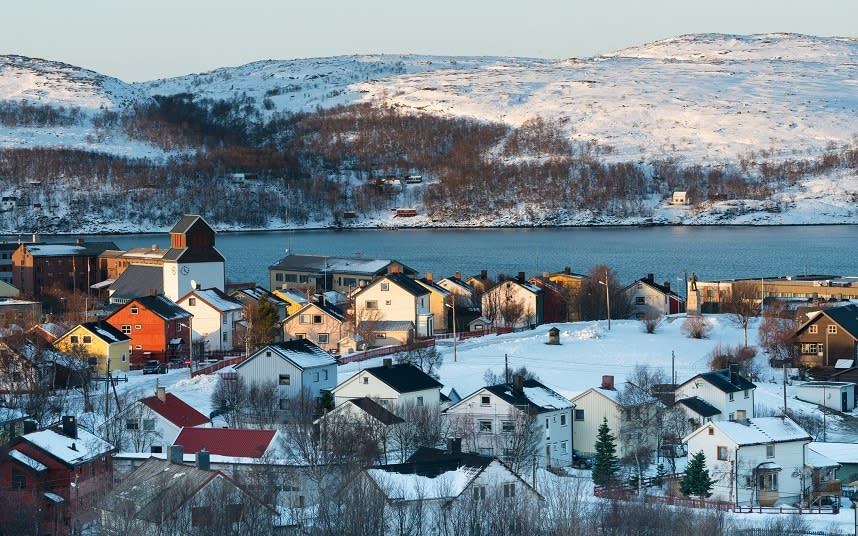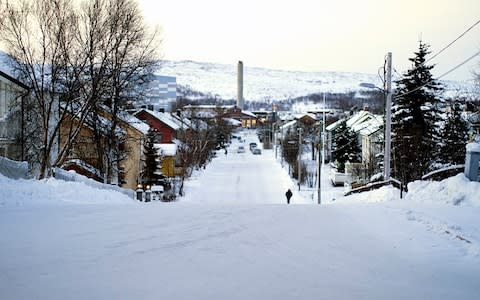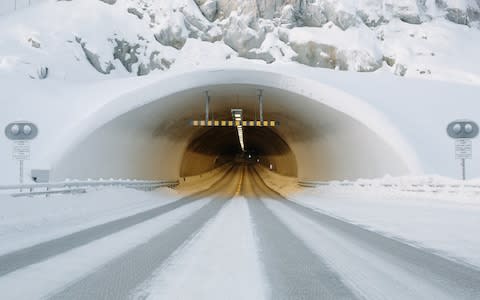A portrait of Kirkenes, the most isolated town in Europe

If Norway were the size of your right arm, Oslo would be your thumbnail, Bergen and the fjords on your wrist, and the Arctic city of Tromso perched on your tricep. Finally, there is the region of Finnmark going over the top of Finland, until Norway actually touches Russia at your shoulder joint. This is where you can find the remotest town in Europe.
Kirkenes is north of Iceland and east of Estonia, nearer to St Petersburg than it is to Oslo. The closest city is Murmansk, Russia. The airport reminded me of that scene in Rocky IV, when Sylvester Stallone steps off the plane to a wind-blasted, snow-covered runway, but within minutes I was in the town centre.
Kirkenes means “church on a headland” and it sits between two ice-filled fjords, leading to the Barents Sea. The port, where Russian trawlers repair nets and cages, is also the final stop of the Hurtigruten ferry service.
That’s how most tourists arrive in Kirkenes and, every morning, coaches take visitors on a whirlwind tour of the area, returning them at midday for the ferry’s return leg. I joined a coach tour to visit the Storskog Border crossing with Russia. During the Cold War, this was the start of the Iron Curtain.
“Don’t go too far,” says the guide, Ernst Sneve, “Or you’ll have the FSB after you!”
Ernst was born in 1936 and has seen every phase of Norway’s relationship with Russia.
“I remember the Soviet troops liberating us from the Nazis,” he says, “Then, when this was the Iron Curtain, only officials could cross. But now, if you live within 40 kilometres of the border you don’t even need a visa. It’s good for buying cheap gasoline.
“Or vodka,” he adds with a conspiratorial wink.
Beyond liberation, the Soviets gave Kirkenes another gift, the giant King Crab.
“They’re an invasive species,” says Ernst, “Soviet scientists introduced them on the Russian side from the Bering Strait in the 1960s, and their population exploded. They’re no good for the ecosystem, but they’re great for the economy. That’s why you see all those trawlers and cages in the port.”

To find out more, I hopped on a snowmobile with Goran, a Serb-Croat who moved here a few years ago.
“The light here is amazing,” says says, “It changes from the polar night, when its dark for months and you see the Northern Lights constantly, to the polar day, when it feels like the golden hour before dusk forever.
“And then there’s the landscape,” he says, “Hold on tight, we’re heading out to sea.”
Soon we were racing over the vast flat whiteness of a frozen fjord. We pulled up next to a winch and Goran turned off the engine. He pulled aside a rubber mat, revealing a slushy square hole and the black water below. Turning the crank and a cage slowly emerged from the depths, containing two enormous crabs. Holding one by its two longest legs, it was nearly as broad as he was, with claws the size of my hand.
“The bottom of the fjord is crawling with them,” he says, “We come every day and sometimes find five in a cage. They are completely taking over the ecosystem, so hunting them is actually good for the environment. But we kill them before we cook them.”
Back at the Snowhotel, Erik the chef was chucking dozens of crabs into huge steaming vats.

“It’s just fresh water, with a little bit of salt,” he says, handing me a leg and what looked like a nutcracker. I opened the shell to find a huge lump of pink and white meat. Erik squeezed on some lemon and I ate it warm and fresh.
“Delicious, eh?” he says, “Saving the environment never tasted so good!”
Heading back into town, my journey was interrupted by a road barrier, and a team of 14 dogs pulling a sled along the snow. This was the lead competitor of the Finnmarksløpet. At 10 days and 1,200km, its the longest dog-race in the world, and I fancied trying my hand.
The nearby Pasvik Valley runs right along the Russian border, and its remoteness is its greatest asset.
“Few people live along the border,” says Craig Gavan of Birk Husky, “Particularly on the Russian side. So its a huge nature park. There’s only a frozen river between us and Russia, but I wouldn’t recommend walking over. The border is covered by cameras and patrols, so you would be arrested and fined. The wildlife doesn’t have the same problem, so we see everything from bear to lynx.”
After harnessing the excitable huskies to the sled, we head into the wilderness. The only sound was the happy panting of the dogs and the soft swish of the runners on the hard-packed trail. Trees stand buried to their crowns, with only the tracks of hares or foxes disturbing the perfect white blanket of snow.
It was a magical way to explore this unique environment. Kirkenes may be the remotest town in Europe, but it is the perfect place to find things that you couldn’t imagine elsewhere.
Norwegian offer flights from London Gatwick to Kirkenes via Oslo. Ash stayed at Scandic Kirkenes and Kirkenes Snowhotel. King crab safari followed by all-you-can-eat crab is organised by Snowhotel. Birk Husky organised the sledding safari. For more information on Norway, see Visit Norway and Northern Norway.

